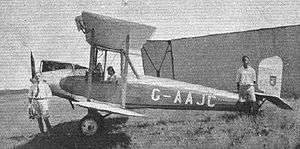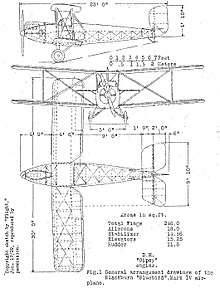Blackburn Bluebird IV
The Blackburn Bluebird IV was a single-engine biplane light trainer/tourer biplane with side-by-side seating designed by Blackburn Aircraft. It was an all-metal development of the wooden Blackburn Bluebird I, II and III aircraft.
| L.1C Bluebird IV | |
|---|---|
 | |
| Role | Tourer /Trainer |
| Manufacturer | Blackburn Aircraft |
| First flight | 1929 |
| Introduction | 1929 |
| Retired | 1947 |
| Produced | 1929–1931 |
| Number built | 58 |
| Developed from | Blackburn Bluebird |
| Variants | Blackburn B-2 |
Design and development
In 1929, Blackburn completely redesigned the wooden Bluebird side-by-side trainer aircraft with an all-metal structure as the L.1C Bluebird IV. With its metal structure, the Bluebird IV was larger and heavier than its wooden predecessors, and was fitted with a nearly rectangular balanced rudder, without a fixed fin to replace the rounded fin and rudder assembly of the wooden Bluebirds. It could be fitted with a variety of engines, with the de Havilland Gipsy, ADC Cirrus or Cirrus Hermes engines available as standard, and could also be fitted with floats. The first Bluebird IV flew in early 1929, and was used to fly its owner home to South Africa in March 1929, completing the journey between Croydon and Durban between 7 March and 15 April 1929.[1] A further two aircraft were built by Blackburn, who were busy fulfilling orders for military aircraft, so further construction was subcontracted to Saunders-Roe, who built a further 55 aircraft [2] with Boulton & Paul Ltd producing the wings.[3]
Operational history
Like the wooden Bluebirds, the Bluebird IV was heavily used by flying clubs, and unfortunately also suffered high attrition, with several being lost in fatal crashes, including a number of unexplained dives into the ground from normal cruising flight.[1]
Privately owned Bluebird IVs undertook a number of pioneering long-distance flights, the most famous of which was the round-the-world trip by Mrs Victor Bruce, and also included a number of flights to Australia and Africa.[1] No Bluebirds survive today, the last being scrapped in 1947.[1]
Operators
Specifications (Bluebird IV (Gipsy I engine))

Data from British Civil Aircraft since 1919, Volume 1 [1]
General characteristics
- Crew: 2
- Length: 23 ft 2 in (7.06 m)
- Wingspan: 30 ft 0 in (9.14 m)
- Height: 9 ft 0 in (2.74 m)
- Wing area: 246 sq ft (22.9 m2)
- Empty weight: 1,070 lb (485 kg)
- Gross weight: 1,750 lb (794 kg)
- Powerplant: 1 × de Havilland Gipsy I 4-cylinder air-cooled in-line piston engine, 100 hp (75 kW)
- Propellers: 2-bladed fixed-pitch propeller
Performance
- Maximum speed: 120 mph (190 km/h, 100 kn)
- Cruise speed: 85 mph (137 km/h, 74 kn)
- Range: 278 mi (447 km, 242 nmi)
- Rate of climb: 730 ft/min (3.7 m/s)
- Wing loading: 7.11 lb/sq ft (34.7 kg/m2)
- Power/mass: 0.057 hp/lb (0.094 kW/kg)
See also
Related development
Aircraft of comparable role, configuration and era
References
- Jackson, A.J. (1974). British Civil Aircraft since 1919, Volume 1. London: Putnam. ISBN 0-370-10006-9.
- Taylor, M J H (Editor) (1989). Jane's Encyclopedia of Aviation. London: Studio Editions. p. 158.CS1 maint: extra text: authors list (link)
- Brew 1993, p. 57
- Brew, Alec (1993). Boulton Paul Aircraft since 1915. London: Putnam Aeronautical Books. ISBN 0-85177-860-7.
External links
| Wikimedia Commons has media related to Blackburn Bluebird IV. |
- The Hon Mrs Victor Bruce's Bluebird
- Blackburn Bluebird – British Aircraft Directory